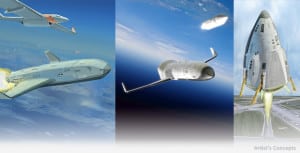DARPA’s XS-1 Reusable Launch Program Starting Phase 2
[Via Satellite 04-08-2016] The U.S. Defense Advanced Research Projects Agency (DARPA) is progressing with the Experimental Spaceplane (XS-1), shifting the program into Phase 2. The XS-1 program seeks to design and fabricate an unmanned, reusable spaceplane that would demonstrate the potential for low-cost and “aircraft-like” high-ops-tempo space flight. According to DARPA, the program could enable a host of critical national security options while helping to launch a new commercial sector. DARPA posted a special notice with FedBizOpps announcing the XS-1 Phase 2 Proposers Day, to be held on Friday, April, 29 in Arlington, Va.
In Phase 1 of XS-1, DARPA awarded prime contracts to three companies, each working in concert with a commercial launch provider: Boeing, working with Blue Origin; Masten Space Systems, working with XCOR Aerospace; and Northrop Grumman, working with Virgin Galactic. Phases 2 and 3 will be competed as a full and open program solicitation mandating an Other Transaction Authority (OTA) agreement with the expectation of a single resulting award.
The XS-1 concept envisions a fully reusable unmanned booster vehicle flying at high speeds to a suborbital altitude and deploying a satellite into Low Earth Orbit (LEO) using one or more expendable upper stages boosters. The reusable first stage would then return to Earth, land and be prepared for the next flight. Although relatively small by conventional aircraft standards, the XS-1 flight booster size — akin to a business jet — would be sufficient to validate credible scaling to larger reusable launch systems.
DARPA’s four primary technical goals with XS-1 are to fly 10 times in 10 days (barring weather, range and emergency delays); achieve sufficient flight velocity to enable use of a small, low-cost expendable upper stage; launch a 900- to 1,500-pound demonstration payload; and reduce the cost of access to space for 3,000 or more pound payloads, with a goal of approximately $5 million per flight for the operational system.
